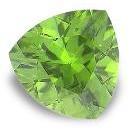|
ClassicGems.net |
|
|
 |
|
Andradite (variety of Garnet) |
|
|
Discovered in 1868; IMA status: Valid (pre-IMA; Grandfathered) |
|||
|
|
|
Chemistry |
|
|
|
|
|
Ca3Fe23+(SiO4)3 |
|
|
|
Calcium Iron Silicate |
|
Molecular Weight: |
508.18 gm |
|
Composition: |
Calcium |
23.66 % |
Ca |
33.11 % |
CaO |
|
|
Iron |
21.98 % |
Fe |
28.28 % |
FeO |
|
|
Silicon |
16.58 % |
Si |
35.47 % |
SiO2 |
|
|
Oxygen |
37.78 % |
O |
|
|
|
|
|
100.00 % |
|
96.85 % |
= TOTAL OXIDE |
|
|
|
||||
|
Classification |
|
|
|
|
|
Silicates (Germanates) |
|
|
8/A.08-110 |
|
|
|
9 : SILICATES (Germanates)
|
|
Related to: |
Garnet Group. Andradite-Grossular Series, Andradite-Schorlomite Series. |
|
Members of Group: |
Garnet Group: Almandine, Andradite, Grossular, Pyrope, Spessartine, Uvarovite |
|
Varieties: |
Bredbergite, Demantoid, Hydroandradite, Melanite, Stanniferous Andradite, Titanoan Andradite, Topazolite |
|
Synonyms: |
Allochroite, Andradite Garnet, Aplome, Jellelite, Jellesite, Jelletite, Kalkeisentongranat, Polyadelphine, Polyadelphite, Rothoffite, Yttergranat |
|
|
|
|
Crystal Data |
|
|
|
|
|
Commonly well-crystallized dodecahedra, trapezohedra, or combinations, to 5 cm. Also granular to massive. |
|
|
None |
|
|
|
|
|
Physical Properties |
|
|
|
|
|
None |
|
|
Irregular/Uneven to Conchoidal |
|
|
Brittle |
|
|
6.5 - 7.0 |
|
|
3.70 - 4.10 (g/cm3) |
|
|
Not Fluorescest |
|
|
Not Radioactive |
|
|
|
|
|
Optical Properties |
|
|
|
|
|
Yellow, Greenish Yellow to Emerald-Green, dark Green; Brown, Brownish Red, Brownish Yellow; Grayish Black, Black; may be sectored. |
|
|
Transparent to Translucent |
|
|
Adamantine to Resinous, Dull |
|
|
1.887 Isotropic |
|
|
0.000 (Isotropic minerals have no birefringence) |
|
|
0.057 (large) |
|
|
None |
|
|
Typically weakly anisotropic |
|
|
|
|
|
Occurances |
|
|
|
|
|
Geological Setting: |
In skarns from contact metamorphosed impure limestones or calcic igneous rocks; in chlorite schists and serpentinites; in alkalic igneous rocks, then typically titaniferous. |
|
Common Associations: |
Vesuvianite, Chlorite, Epidote, Spinel, Calcite, Dolomite, Magnetite. |
|
Common Impurities: |
Ti, Cr, Al, Mg |
|
Type Locality: |
Drammen, Buskerud, Norway |
|
Year Discovered: |
1868 |
|
View mineral photos: |
|
|
|
|
|
More Information |
|
|
|
|
|
|
|
|
|
|
|
Andradite is a member of the Garnet Group of minerals that includes Almandine, Andradite, Grossular, Pyrope, Spessartine and Uvarovite. Andradite's various colors include yellow, greenish yellow to emerald-green, dark green, brown, brownish Red, brownish Yellow; grayish black and black. Andradite is found in several varieties including Demantoid, Melanite and Topazolite. Demantoids are the rich green variety colored by chromium and are the best known of the Andradites. Demantoid is named from the archaic German word "demant" which means "diamond" in allusion to its very high brilliance resembling that of Diamond. Melanites are typically black and contain about 1-5% titanium oxide. Melanite is named from the Greek word "melan", meaning black. Topazolites are a rare yellow to golden yellow variety named for its resemblance in color and clarity to Topaz. Andradite was named in 1868 by American geologist and mineralogist James Dwight Dana (1813-1895) in honor of José Bonifácio de Andrada e Silva (1763-1838), Brazilian mineralogist who first described the mineral. José Bonifácio was a mineralogist, naturalist, poet and professor of geology. He discovered and named four new mineral species: Cryolite, Petalite, Scapolite and Spodumen. He also named these eight mineral varieties (or synonyms): Acanthicone (syn. of Epidote), Allochroite (syn. of Andradite), Aphrizite (a black variety of Tourmaline), Coccolite (syn. of Diopside), Ichtyophtalme (syn. of Apophyllite), Indicolite (blue variety of Tourmaline),Salite (variety of pyroxene) and Wernerite. José Bonifácio named most of the minerals which he discovered with scientific names derived from Greek words, with the exception of Wernerite. Wenerite was named in 1800 by José Bonifácio to honor Abraham Gottlob Werner (1749-1817), a professor of mining and mineralogy at the Freiberg Mining Academy, Germany. Werner was an influential teacher and his ideas shaped early geological thought. He has been called the "father of German geology". In September 1792, José Bonifácio went to Germany to attend the Frieberg Mining Academy to study under Werner. Distribution: widespread; fine examples from; in Italy, at Frascati, Alban Hills, Lazio; the Val Malenco, Lombardy; the Ala Valley, Piedmont; and Larcinaz, Val d'Aosta. At Dognecea (Dognaczka) and Oravi»ta (Oravicza), Banat, Romania. From Ocna de fier, Romania (Vaskö, Hungary). At Zermatt, Valais, Switzerland. From Arendal, Norway. In the Wessels mine, near Kuruman, Cape Province, South Africa. In Russia, gem crystals from the Bobrovka River, Nizhni Tagil district, and the Sissertsk district, Ural Mountains; at Sineretschenskoje, north of Vladivostock. In the USA, from Stanley Butte, Graham County, Arizona; on Garnet Hill, Calaveras County, and around the Gem mine, San Benito County, California; at Franklin and Sterling Hill, Sussex County, New Jersey; from Magnet Cove, Hot Spring County, Arkansas; and on Prince of Wales Island, Alaska. In Mexico, found near Charco de Peña, about 75 km east of Lázaro Cárdenas, Chihuahua. |
|
|
Andradite gems for sale: Please visit the Demantoid, Melanite and Topazolite pages for our Andradite gems for sale. |